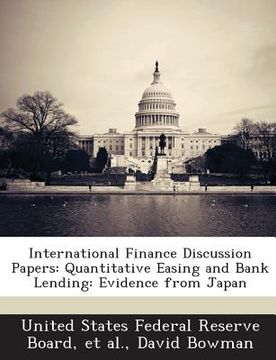Compartir
International Finance Discussion Papers: Quantitative Easing and Bank Lending: Evidence from Japan (en Inglés)
Patxi Zabaleta
(Autor)
·
David Bowman
(Autor)
·
United States Federal Reserve Board
(Autor)
·
Bibliogov
· Tapa Blanda
International Finance Discussion Papers: Quantitative Easing and Bank Lending: Evidence from Japan (en Inglés) - Bowman, David ; United States Federal Reserve Board ; Et Al
25,16 €
26,48 €
Ahorras: 1,32 €
Elige la lista en la que quieres agregar tu producto o crea una nueva lista
✓ Producto agregado correctamente a la lista de deseos.
Ir a Mis Listas
Origen: Estados Unidos
(Costos de importación incluídos en el precio)
Se enviará desde nuestra bodega entre el
Martes 16 de Julio y el
Martes 30 de Julio.
Lo recibirás en cualquier lugar de España entre 1 y 5 días hábiles luego del envío.
Reseña del libro "International Finance Discussion Papers: Quantitative Easing and Bank Lending: Evidence from Japan (en Inglés)"
Prior to the recent financial crisis, one of the most prominent examples of unconventional monetary stimulus was Japan's "quantitative easing policy" (QEP). Most analysts agree that QEP did not succeed in stimulating aggregate demand sufficiently to overcome persistent deflation. However, it remains unclear whether QEP simply provided little stimulus, or whether its positive effects were overwhelmed by the contractionary forces in Japan's post-bubble economy. In the spirit of Kashyap and Stein (2000) and Hosono (2006), this paper uses bank-level data from 2000 to 2009 to examine the effectiveness in promoting bank lending of a key element of QEP, the Bank of Japan's injections of liquidity into the interbank market. We identify a robust, positive, and statistically significant effect of bank liquidity positions on lending, suggesting that the expansion of reserves associated with QEP likely boosted the flow of credit. However, the overall size of that boost was probably quite small. First, the estimated response of lending to liquidity positions in our regressions is small. Second, much of the effect of the BOJ's reserve injections on bank liquidity was offset as banks reduced their lending to each other. Finally, the effect of liquidity on lending appears to have held only during the initial years of QEP, when the banking system was at its weakest; by 2005, even before QEP was abandoned, the relationship between liquidity and lending had evaporated.
- 0% (0)
- 0% (0)
- 0% (0)
- 0% (0)
- 0% (0)
Todos los libros de nuestro catálogo son Originales.
El libro está escrito en Inglés.
La encuadernación de esta edición es Tapa Blanda.
✓ Producto agregado correctamente al carro, Ir a Pagar.

